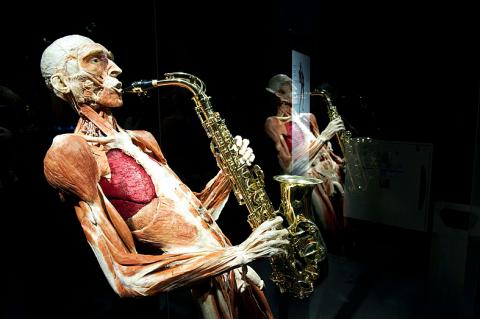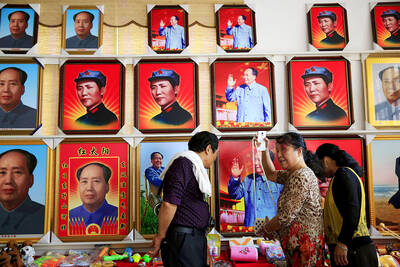Seven years after its Taiwan debut, anatomical exhibition Body Worlds returns with a new exhibition titled Body Worlds & The Cycle of Life (人體奧妙之生命巡迴展), which comprises more than 200 preserved human and animal specimens. The 2004 exhibition aimed to educate the public about the beauty and fragility of the body, while The Cycle of Life focuses on the process of aging.
On display at the National Taiwan Science Education Center (台灣科學教育館) in Taipei’s Shilin District (士林) until Sept. 25, the exhibition of human “plastinates” begins with fetal development and includes detailed introductions to all the organ systems, including specimens with deformities.
Body Worlds was originally developed by German anatomist Gunther von Hagens, who in 1977 invented what he calls the plastination preservation technique, which involves replacing the specimen’s water and fat with reactive polymers such as silicone rubber. The Body Worlds Web site (www.bodyworlds.com) says it takes about one year to plastinate a human body.

Photo: EPA
Body Worlds & the Cycle of Life is open to viewers of all ages, but some may find viewing an exhibition that includes a splayed human head distasteful.
■ Until Sept. 25 at National Taiwan Science Education Center (台灣科學教育館), 189 Shishang Rd, Taipei City (台北市士商路189號)
■ Monday to Friday from 9am to 5pm, weekends and public holidays from 9am to 6pm
■ Admission is NT$280 for adults, NT$250 and NT$140 for concessions. Tickets are available online (www.walkieticket.com) and at the door. Audio guide players in English and Mandarin are available for NT$100
■ On the Web: www.bodyworlds.com.tw

Taiwan can often feel woefully behind on global trends, from fashion to food, and influences can sometimes feel like the last on the metaphorical bandwagon. In the West, suddenly every burger is being smashed and honey has become “hot” and we’re all drinking orange wine. But it took a good while for a smash burger in Taipei to come across my radar. For the uninitiated, a smash burger is, well, a normal burger patty but smashed flat. Originally, I didn’t understand. Surely the best part of a burger is the thick patty with all the juiciness of the beef, the

The ultimate goal of the Chinese Communist Party (CCP) is the total and overwhelming domination of everything within the sphere of what it considers China and deems as theirs. All decision-making by the CCP must be understood through that lens. Any decision made is to entrench — or ideally expand that power. They are fiercely hostile to anything that weakens or compromises their control of “China.” By design, they will stop at nothing to ensure that there is no distinction between the CCP and the Chinese nation, people, culture, civilization, religion, economy, property, military or government — they are all subsidiary

Nov.10 to Nov.16 As he moved a large stone that had fallen from a truck near his field, 65-year-old Lin Yuan (林淵) felt a sudden urge. He fetched his tools and began to carve. The recently retired farmer had been feeling restless after a lifetime of hard labor in Yuchi Township (魚池), Nantou County. His first piece, Stone Fairy Maiden (石仙姑), completed in 1977, was reportedly a representation of his late wife. This version of how Lin began his late-life art career is recorded in Nantou County historian Teng Hsiang-yang’s (鄧相揚) 2009 biography of him. His expressive work eventually caught the attention

This year’s Miss Universe in Thailand has been marred by ugly drama, with allegations of an insult to a beauty queen’s intellect, a walkout by pageant contestants and a tearful tantrum by the host. More than 120 women from across the world have gathered in Thailand, vying to be crowned Miss Universe in a contest considered one of the “big four” of global beauty pageants. But the runup has been dominated by the off-stage antics of the coiffed contestants and their Thai hosts, escalating into a feminist firestorm drawing the attention of Mexico’s president. On Tuesday, Mexican delegate Fatima Bosch staged a